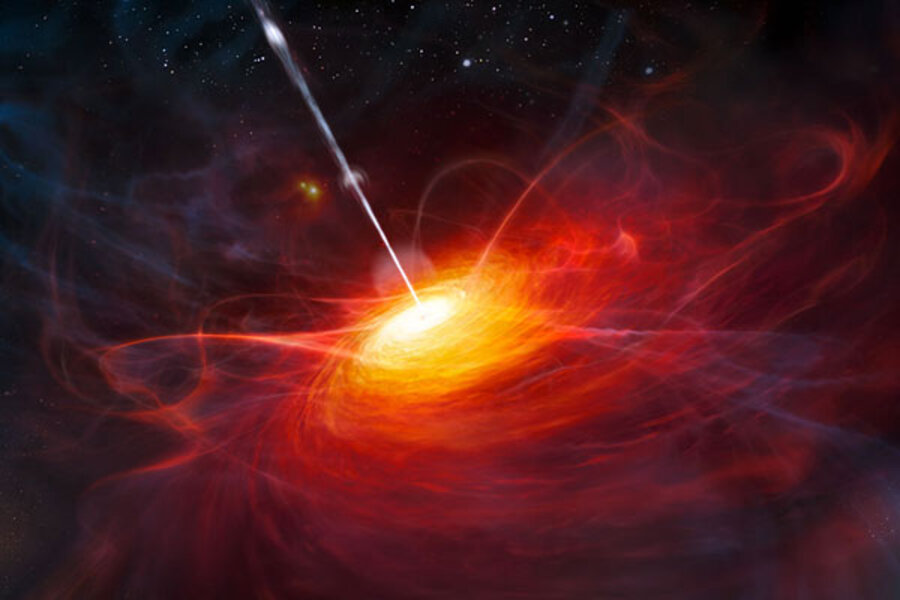Astronomers report largest structure in universe. Will it upend theories?
Loading...
What could be the largest structure yet seen in the observable universe has emerged from data taken during a 12-year survey of the night sky.
The discovery is an apparent cluster of quasars some 4 billion light-years across. If it holds up to further scrutiny, it could challenge a long-held assumption that at the cosmos's largest scales, the physical processes at work and the distribution of matter and energy are the same, regardless of an observer's location.
That's the view of the team formally reporting the results Friday in the journal Monthly Notices of the Royal Astronomical Society.
Quasars are the hyperactive centers of large galaxies and are among the brightest, most energetic objects in the sky. Some recent theoretical work suggests that the upper limit to the largest gatherings of galaxies is about 1.2 billion to 1.5 billion light-years across. The structure that the team reports is nearly four times larger than this theoretical limit.
Other researchers caution that evidence in the new discovery isn't strong enough to challenge this notion of large-scale uniformity, dubbed the cosmological principle.
But, they add, the work does highlight a key question in modern cosmology: What is the size scale at which the wildly uneven distribution of matter seen at small cosmic scales gives way to a uniform average across the universe as a whole?
"We don't know that," says Margaret Geller, an astronomer at the Harvard-Smithsonian Center for Astrophysics in Cambridge, Mass., whose research focuses on how the universe and its cosmic-scale structures formed and evolved. "And this is an indication that we don't know that."
Astronomers snagged their first large cluster of quasars in 1982, says Roger Clowes, an astronomer at the University of Central Lancashire in Britain and the leader of the research team reporting the new results. By 1991, two more large clusters had been found. With the advent of the Sloan Digital Sky Survey in 2000, more have appeared, including the latest discovery.
But the latest find, which the team has informally named the Huge Large Quasar Group, or Huge-LQG, is the biggest so far. It lies some 8 billion to 9 billion light-years away and contains 73 quasars. These quasars represent the tip of the iceberg, with many more galaxies present in the group that are too faint for researchers to see. The team estimates the Huge-LQG's mass at more than 3,000 trillion times the mass of the sun – or about 1,300 times the mass of the Coma Cluster, which hosts more than 1,000 galaxies.
Collectively, these large quasar groups represent about 10 percent of quasars cataloged so far, "so they're not that common," Dr. Clowes says. "But when they occur, they can be quite dramatic."
Interest in this latest large quasar group stems from assumptions – the cosmological principle – that Albert Einstein made as he applied his equations of general relativity to the cosmos. The assumption greatly simplified his calculations, which pointed to a size threshold for individual structures beyond which the distribution of matter would appear uniform.
Over the years, as astronomers have detected ever-larger groups of galaxies, and later interwoven filaments of galaxies, the threshold has increased, Clowes explains. It started out at about 98 million light-years and now hovers at the 1.2 billion-light-year mark.
Thus, the large cluster that the team has found could represent the first hint of a new, improved threshold. Or if more observations identify it as a truly rare structure, it could indicate that the universe might not be so uniform after all, forcing a major overhaul of theories about how the universe has evolved.
"For example, some directions of the sky would be special; the universe would not expand at the same rate in all directions," says Avi Loeb, an astrophysicist who heads the astronomy department at Harvard University in Cambridge, Mass.
In addition, the cosmic microwave background would be significantly hotter in one part of the sky than in others. That background, which has been measured to exquisite precision, is the afterglow of the big bang, the enormous release of energy that gave rise to the universe some 13.8 billion years ago.
Yet several independent lines of evidence argue for a uniform universe at its largest scales. One of the most powerful involves the microwave-background measurements. The radiation is remarkably uniform throughout the sky. Any deviations are extremely subtle – one part in 100,000, Dr. Loeb says.
It's unclear whether the cluster that the team has identified truly is a single structure, Loeb and Dr. Geller say. For instance, what looks like one enormous cluster may actually be two structures that look as though they are one because of the viewing angle from Earth. More modeling work and observations will be needed to establish the true structure of the apparent large cluster, they say.








